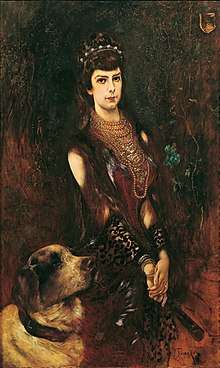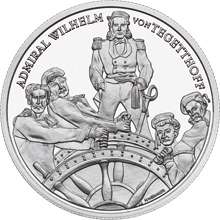Anton Romako
Anton Romako (20 October 1832 – 8 March 1889) was an Austrian painter.

.jpg)


Life
Anton Romako was born in Atzgersdorf (now a district of Liesing, Vienna), as an illegitimate son of factory owner Josef Lepper and his Czech housemaid Elisabeth Maria Anna Romako (Rhomako, Romakho, née Hromádko).[1] He studied painting at the Academy of Fine Arts Vienna (1847–49) but his teacher, Ferdinand Georg Waldmüller, considered him talentless. Later, he studied in Munich (1849) under Wilhelm Kaulbach, and subsequently in Venice, Rome and London. In the early 1850s he studied privately in Vienna under Carl Rahl, whose style Romako adopted. In 1854 he began travels to Italy and Spain and in 1857 settled in Rome as the favourite portrait, genre, and landscape painter for the local colony of foreigners.
In 1862 Romako married Sophie Köbel, the daughter of architect Karl Köbel, and the pair had five children before Sophie left Romako in 1875 for her lover. In 1876 Romako returned to Vienna but failed to re-establish himself against the style represented by Hans Makart and increasingly relied on the charity of such wealthy patrons as Count Kuefstein. He made study trips to Hungary, Italy and France, and during the years 1882 to 1884 he alternated between Paris and Geneva. Two daughters, Mathilde and Mary, committed suicide in 1887; Romako never recovered from the shock. His last years were spent living in neglect near Vienna, where he died in poverty in 1889. Romako was buried at the Central cemetery in Vienna.
In 1953 a street in Atzgersdorf was named after the painter: Romakogasse. Anton Romako's painting The Battle of Lissa was selected as a motive for a recent commemorative coin: the 20 euro S.M.S. Erzherzog Ferdinand Max minted on September 15, 2004.
His brother, Josef von Romako, was a Naval Architect-Inspector of Austro-Hungarian Navy.
Works
Romako painted a large number of landscape scenes (for example from the Bad Gastein), influenced by the Barbizon school, but is known mostly for his portraits and historical scenes. His early works display the influence of Biedermeier realism, while the late works are painted in a nervous expressionist style which disturbed his contemporaries. More than a decade passed before his works were reconsidered and appreciated.
Nowadays Romako is seen as one of the most interesting and trailblazing artists of the "Ringstraßenepoche" era. He was impressed by the young Oscar Kokoschka and had a great influence on his work. Many paintings of Anton Romako are shown in the Belvedere gallery in Vienna.
His famous portrait of empress Elisabeth, showing her eccentric personality, was generally rejected at the time. His best-known work, the portrait of Admiral Wilhelm von Tegetthoff during the naval Battle of Lissa, shows the admiral and a few sailors without the usual heroism at the moment when his ship Ferdinand Max is going to ram an Italian flagship.
List of works
- Die Eitelkeit - Porträt seiner Brau Sophie Köbel (Salzburg, Residenzgalerie), around 1860, oil on canvas, 124 x 91 cm
- Fischerknabe am Meeresstrand (Fisherboy at seashore) (Wien, Österreichische Galerie), around 1873-75, oil on wood, 90 x 70 cm
- Mädchen mit Kaninchen (Girl with a rabbit) (St. Pölten, Niederösterreichisches Landesmuseum), about 1877, oil on canvas, 72,7 x 60,6 cm
- Admiral Tegethoff in der Seeschlacht bei Lissa (Admiral Tegethoff at the 1866 naval battle of Lissa) (Wien, Österreichische Galerie), 1878–80, oil on wood, 110 x 82 cm
- Am Wasserfall (At the waterfall) (Wien, Leopold Museum), 1881, oil on canvas, 89,3 x 63 cm
- Kaiserin Elisabeth (Empress Elisabeth) (Wien, Österreichische Galerie), 1883
- Die Rosenpflückerin (Wien, Österreichische Galerie), 1883, oil on canvas, 89 x 66 cm
- Mutter und Kind (private collection), 1883, oil on canvas, 161 x 130 cm
- Junge Frau vor Bildstock (private collection), 1883, oil on wood, 54,4 x 45,5 cm
- Südfranzösische/Bretonische Bäuerin (Graz, Landesmuseum Joanneum), 1884, oil on canvas, 50,5 x 38,5 cm
- Mädchen, einen Fink anlockend (St. Pölten, Niederösterreichisches Landesmuseum), around 1884/85, oil on wood, 45,2 x 28 cm
- Bildnis Isabella Reisser (Wien, Leopold Museum), 1885, oil on canvas, 130.5 x 90 cm
- Herr und Dame im Salon (Museen der Stadt Wien), 1887, oil on wood
- Dame in rotem Kleid (Wien, Österreichische Galerie), 1889, oil on canvas
- Portrait of August Wassermann (Budapest,Museum of Fine Arts)
- Girl on a Swing (Olga von Wassermann) (Northampton, MA, USA, Smith College Museum of Art), ca. 1882, oil on canvas, 160 x 122 cm

References
- "City of Vienna". Archived from the original on 2018-07-08. Retrieved 2018-07-07.
Further reading
- Blackshaw, Gemma (2008)."Rediscovering Anton Romako", in From "Ausgleich to "Jahrhundertwende": Literature and Culture, 1867-1890, Austrian Studies, vol. 16: 105-122.
- Esau, Erika (1985). Anton Romako's portraits and the beginnings of Modernism in Vienna, (PhD diss., Bryn Mawr College), Ann Arbor, Michigan.
External links
| Wikimedia Commons has media related to Anton Romako. |
- Short biographies in English: , ,
- Literature about Romako in German